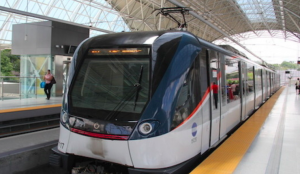In a joint press conference given by Panama’s Foreign Minister and Chinese Chancellor Wang Yi this September 17th, it was announced that plans were being examined as to the feasibility of constructing a 500km-long light railway to connect Panama City with David. This could have the potential to be big news for both domestic and foreign business interests, as well as tourism between the country’s two principal cities. Currently, the only way to access David from Panama City (and vice versa) by land is the Panamerican Highway, which routinely has traffic issues, and is undergoing its own perpetual expansion to meet demand. Right now, plans are to simply study the economic and physical possibility of such a project, however, it’s peaked national interest, as it would alleviate many of the country’s ground shipping logistics problems, not to mention make it easier for passengers to travel.
What a Panama City to David Railway would look like
More than likely the railway would have to be built alongside the current Panamerican Highway infrastructure. The train would begin on the west side of the Panama City suburb of Arraijan, where Line 3 of the Metro is scheduled to end and continue to the center of David, where a new train terminal would be constructed. This would link Panama City’s urban Metro transport to the railway, and essentially connect it to the airport in the east by transfer. It would also avoid construction within the center of the city, which is critical for any new project of this size. Both cargo and passenger trains would use the rails, meaning that the size should be pretty big, and also requiring many local stations and unloading docks to be built in the process.
The proposed railway would be built in three stages of development, going first from Panama City to Penonome, then to Santiago, and ultimately to David.
Why this matters, and how it will affect Panama’s business and tourism
According to officials from the Panama Transportation Authority, the study of the feasibility of a light rail from Panama City to David will take about a year, and be entirely funded by the Chinese. This study, and subsequent construction if possible, is a big deal because it will open up the country to much easier domestic trade and transportation. For people who live and work in the interior of the country, it will make access to principal cities more comfortable and efficient, as well as boosting domestic trading for both small an large businesses. It will also alleviate traffic, which is a major issue due to lack of highways connecting the country. As far as tourism goes, it will help open up Chiriqui and western provinces even more than they currently are, and bring people to towns they otherwise would have never visited by bus or car rental.
While this is still clearly a few years away, it seems to be a step in the right direction. Critics believe that this may be just the beginning of China influencing (and participating in) Panamanian domestic projects, however the practical benefits are hard to ignore. Better, more efficient transportation is desperately needed in nearly all parts of the country, and this may be just what the doctor ordered to get the ball rolling on many other highway/railway infrastructure projects.
